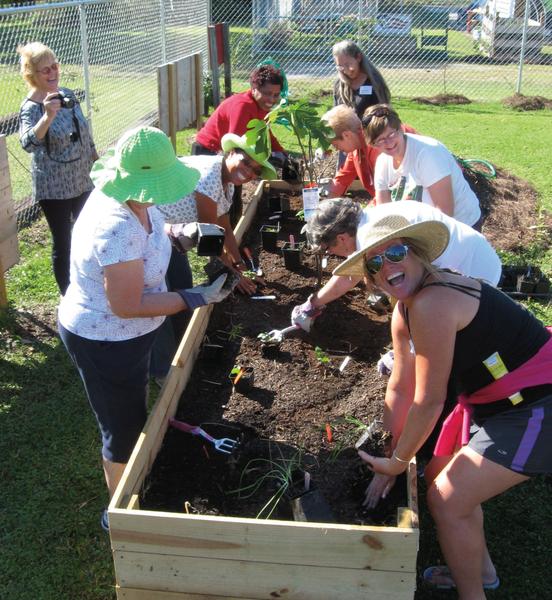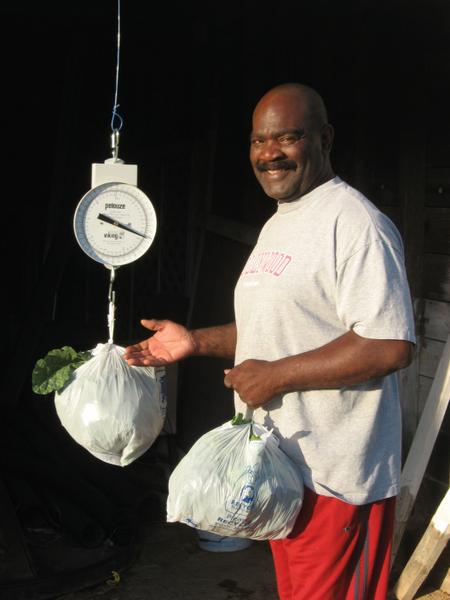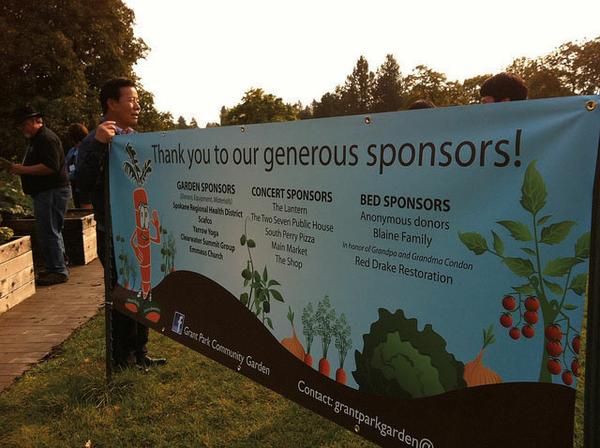Community food gardens have relatively low start-up costs and modest annual maintenance budgets compared to many other types of community development projects. Most do, however, require a modest amount of cash.
Gardens benefit from a simple, realistic budget and an effective fundraising program. Fundraising offers another opportunity to engage the talents and energy of gardeners, volunteers, and supporters.
Cutting Costs
Any money a garden doesn’t need to spend is money earned. Save money by scrounging recycled tools and growing seedlings. Creative frugality can be fun, sets a good example, and teaches important lessons in stewardship.
Budgeting
A start-up budget for a basic community food garden on a quarter-acre lot in North Carolina ranges from roughly $1,000 to $5,000, not counting the salary of paid staff. Fencing and water hookup tend to be the largest costs. Donations and sweat equity labor by gardeners and volunteers can reduce the budget.
The regular maintenance budget for an average community food garden is typically a fraction of the start-up budget. Annual maintenance budgets are often well under $1,000, excluding salaries. This amount can be further reduced through donations and volunteer labor.
Annual costs include water, compost, mulch, soil preparation, new and replacement tools, and maintenance costs and rent payments. Ambitious one-time projects, such as building a shed or expanding the garden, can temporarily—but substantially—increase an annual budget. Seeds and seedlings may be available as donations, but the quality may or may not be suited to gardening success.
Finding resources
Many individuals and organizations are happy to help community food gardens. Civic groups and businesses can support a community garden by providing volunteers, financial contributions, and in-kind donations. For instance, tree companies are often willing to drop wood chips beside the garden gate as free mulch, a win-win for both gardeners and the tree company.

Lisa Valdivia CC BY-NC 4.0
Funding
Even with generous contributions, dedicated volunteers, and creative frugality, most gardens still need other sources of cash. Community gardens generate needed funds through a combination of fundraising, dues, donations, and grants.
Fundraising
Fundraising is a straightforward way to raise money. It has the added benefit of garnering good publicity, reaching out to the community, and building relationships among gardeners working on a joint project. Potluck dinners, bake sales, car washes, and silent auctions can all effectively raise money. Crowdfunding sites, such as Kickstarter, and other web-based fundraising resources are also viable options.
Look for potential sources of funding, such as private businesses, public agencies, non-profit organizations, and individuals. Enlist help from gardeners and supporters to establish personal connections with donors in the community.
Dues
Assessing modest dues of between $5 and $50 per plot annually is common practice for community food gardens. Giving gardeners a chance to buy into the garden is beneficial even if the amount of cash generated is very modest.
To make sure no one is excluded because they can’t afford dues, set up a scholarship program that gives gardeners a chance to work off their dues by contributing in other ways, such as volunteering in the garden or the community.
Grants
Grants are a viable and valuable source of supplemental funding, and getting a grant can be a great morale boost for the garden. Don’t be tempted to rely on grants for long-term support, however. What happens when the grant is gone?
Writing a successful grant takes time and skill and requires long-term reporting responsibilities. Make sure the garden has the capacity to handle both the application and reporting process. Despite these administrative requirements, grants are still important sources of start-up and operating funds. Gardens that successfully obtain grants are able to establish contacts and legitimacy for the garden and create opportunities for long-term sources of financial support.
Community Garden Evaluation
Evaluation is a powerful tool to keep a community garden learning, growing stronger, and doing an even better job. Sponsors, funders, and grant organizations understandably want information that demonstrates results and helps them gauge the effectiveness of their contributions. Normally they require specific quantifiable (countable) data, and the garden must be able to provide this information. For instance, these data might include how many people participated in the garden or how much food the garden produced.
To most effectively communicate the garden’s value, however, gardeners and garden supporters must dig deeper to show the garden’s overall impact. The garden grows food, cultivates community, and builds social capital. Document the garden’s successes not just with numbers but also with narratives, pictures, and thoughtful analysis. Consider creating an annual report that summarizes key findings and post it on the garden website.
Telling Your Story
The most powerful way to educate people about the value of community food gardening is simple, old-fashioned, and low tech—tell a story. Gardens are full of fascinating tales of gardeners’ lives and lessons learned from growing food. Sometimes poignant, sometimes funny, often full of insight, stories explain the value of the garden in a memorable and effective way.

Lisa Valdivia CC BY-NC 4.0
Sponsors and Agencies
If the garden has a sponsor or public agency that pays the bills, it’s still wise to think carefully about evaluation and fundraising.
It is always important to be able to demonstrate the garden’s successes and benefits to the larger community, as well as to the gardeners. Showing the garden’s value is even more important in tight economic times.
Over time, non-profit and government agency priorities change, and different personalities may influence decisions. Keep track of how much food the garden produces and how many families it benefits to make a strong case for continued funding even when personnel changes or organizational goals shift.
Funds raised for a garden that is part of a larger organization may automatically be channeled into the sponsoring agency’s general accounts. Before beginning a fundraising effort, be sure to clarify where the money will be deposited and who will be able to decide how it is spent.
Some gardens form independent support groups—friends of the garden or community gardener organizations—to raise money specifically for the garden and to seek grants. These funds stay under the control of the group and typically are used to directly benefit the garden. Forming such a group is sometimes the first step toward the garden becoming more independent, as discussed in the next chapter.

Gail Langellotto CC BY-NC-ND 4.0
Publication date: Aug. 10, 2017
AG-806
Other Publications in Collard Greens and Common Ground: A North Carolina Community Food Gardening Handbook
N.C. Cooperative Extension prohibits discrimination and harassment regardless of age, color, disability, family and marital status, gender identity, national origin, political beliefs, race, religion, sex (including pregnancy), sexual orientation and veteran status.
